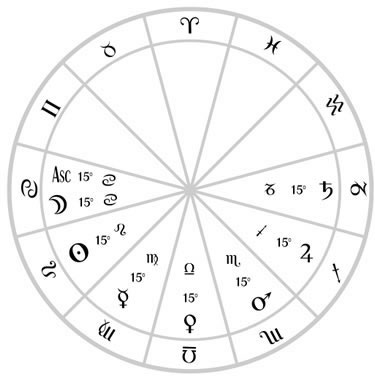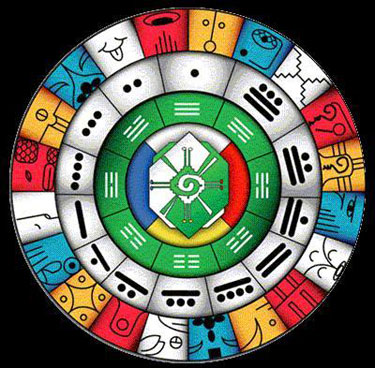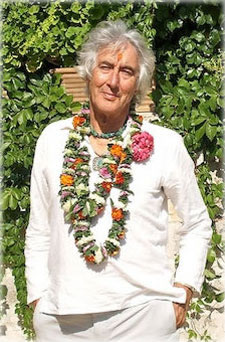Navigate Signs:
Recent Posts
Archives
Featured links:
Category Archives: 2012 Diary
Special Edition Audio: It’s All About the Houses
[audio:http://planetwaves.fm/podcast/111230signs.mp3]

In this special edition of Planet Waves FM, I explore one of the most commonly asked questions about “general” readings — how does the astrologer make them specific? How can we get any detail at all, just knowing someone’s Sun sign? (By the way I just heard a ridiculous verbal typo – toward the beginning, I say the word ‘simultaneously’ when I mean ‘synonymously’. It’s an interesting blend of concepts anyway, as one implies time and the other implies meaning.)

The Thema Mundi, the key to the logic of astrology, including rulership, aspects, house meanings and the basic order of the solar system. It is probably modern astrology's oldest artifact besides mythology itself, dating back to ancient Greece.
This discussion will be interesting for both astrology fans and astrology students. I describe the solar house system, which counts the houses off of the Sun, and the whole sign house system, which uses the whole sign as a house. I also describe how astrology is a holographic art — and because I am using a whole chart for each of the readings, I can interpret a complete story that you can relate to.
Technical note: “ascendant,” “1st house” and “rising sign” are all the same thing, for our purposes here.
There are a few resources that might help ease your way, if you want to go deeper into understanding the astrological houses. One is a basic description of house meanings. Here is another one, that focuses on sexual themes through the houses. In this article from way back when the Internet was young, I describe how horoscope writers use the solar houses and whole sign houses. Finally, in this article from Cosmic Confidential, I describe my holographic method of reading for the signs, which allows the use of a full chart — granted, a simpler chart — and why it helps that an astrologer sees the whole chart and creates a cohesive narrative. That, I think, is the key. Okay so — just thought of one other, one that skips back into the earliest history of astrology as we know it in old Greece – the Thema Mundi. The Thema Mundi may be modern astrology’s oldest artifact. It’s a single chart, a teaching chart, that describes the logic system behind astrology.
Posted in 2012 Diary
Leave a comment
Top Five Events: The ‘End’ of the Mayan Calendar
[audio:http://planetwaves.fm/podcast/120101top5.mp3]
Note — I’ve added the second part of this edition — the interview with Carlos Cedillo, the Mayan daykeeper, who explains various aspects of the Mayan calendars. It’s about a one-hour interview and you can hear it in this area devoted to the Top Five Events of 2012.
Good evening. I’ve just recorded a new entry in the Top Five Events of 2012 series, this one addressing the Mayan calendar systems and what day 13.0.0.0.0 on Dec. 21, 2012 might “mean.” It’s actually a critique on attempts to pin too much meaning on the day. And, for the most part, I’m not up to giving my opinion yet — though I do provide some thoughts by other writers. There will be two more parts to this part — next, an interview with Carlos Cedillo, a daykeeper, and then the last in the series — my own viewpoint on the matter of the Mayan calendar and 2012. You do get a bit of that in this recording, but not the heart of my theory.
The article I reference by Bruce Scofield will appear in the rapidly growing resources area for the Reality Check website. This presentation will appear in the Top Five Events special area as well. If you want to pre-order your Reality Check reading, check the the link on the top of the right column.
Posted in 2012 Diary
Leave a comment
Friday evening, 7 pm
As I may have mentioned, I am now up to the written portion. Audio is done and edited and being posted to the website now. We are going to wait until the written reports are done before opening up the site. That will be some time around next weekend. I am making good progress, approximately one sign per day, but this is stuff that has to be written carefully, editing as I go.

One representation of the Tzolk
On Wednesday night, I got involved in a side project — delving into one particular theory of the Mayan calendar that has been irritating me for years. Using various books, contacting a few different mentors and working with information I already understood, I began to debunk that particular theory and started to move onto others that made more sense. All of this, by the way, is in preparation for my audio on 13.0.0.0.0 — that is, the turnover of the calendar on 12/21/12. This is the fifth in the Top Five Events of 2012 series, and I expect to do that some time over the weekend.
In the past 48 hours of reading, conversations and thought, I’ve gained a new understanding of both the Mayan tzolk’in (the short count or 260-day calendar) and the long count, which for our purposes goes back 5,125 years. (It actually goes back to the big bang but I am going to skip that for now.)
The long count is the one that is doing some very interesting stuff in 2012 (and has been since March 9, 2011, though this has not received much press). I will get into that shortly; it’s utterly amazing. It turns out that the long count is not merely a linear progression of days. The 13th baktun ends on 12/21/12 — a baktun is 144,000 days, and 13 of them are 1.89 million days. There are all kinds of structures, patterns and rhythms within those flows of days, and we seem to be living them out in palpable ways.
Now, I’ve been collecting information on these calendars going back to 1986. Yet all of a sudden I am feeling the bug bite me — I know it’s time to learn daykeeping in the Mesoamerican tradition. I will be speaking to my two friends who have devoted their lives to daykeeping to see what I can get going in this space, the diary connected to the 2012 annual edition.
Okay — it is back to the Leo written report.
Posted in 2012 Diary
3 Comments
Thursday morning, 4 am
I’ve pulled an all-nighter diving into various Mayan calendar theories. An evening of discovery, focusing mainly on the astronomy. Those old Mesoamerican ways of timekeeping are really cool. They are systems that are based on multiple cycles, and track time by the overlays of the cycles. It keeps their mind on the meta level. I think that part of our problem with time is time itself — that it’s in the nature of linear time to compress like this. The nature of the older methods used in our part of the world would inherently take the mind to a different level, due to playing with metacycles. It’s a more spacious version of time, capable of gracefully moving through long phases. Given this, it’s likely that 12/21/12 coincides with a time pulse of some kind. There is nothing specific to predict this except the calendar itself, and a slightly wider cosmology than Western culture tends toward. It’s easy to see why the presence of the date has given rise to so many visions — that would even seem to be the point.
Posted in 2012 Diary
Leave a comment
The Big Question: What’s so 2012 about 2012?
Dear Friend and Reader:
It was someone named Jose Arguelles who popularized 2012 as the time we would take what he called the leap beyond technology. Arguelles was not the first to point out the significance of 2012 — though he was talking about it as early as the mid-1970s. Frank Waters (in his Hopi prophecies) also mentioned it in 1975, as did Terence McKenna in Invisible Landscape. Astrologer A.T. Mann briefly mentioned it in his 1986 book The Divine Plot: Astrology, Reincarnation, Cosmology and History.

Jose Arguelles at the Babaji Ashram, Cisternino, Italy 2009. Jose is the one who introduced the world to the idea of 2012. He died earlier this year. Photo: Wikimedia Commons.
Yet it was Arguelles’ facilitation (or more accurately co-facilitation) of the Harmonic Convergence in 1987 that got the cultural meme of 2012 (and the Mayan long count) going. The Convergence was based on the idea that the 13th baktun of the Mayan long count calendar would be ending on the winter solstice of 2012, and that it was time to start preparing ourselves for whatever that transition meant. How long is long? A baktun is 144,000 days; 13 baktuns add up to about 1.8 million days, or 5,125 years, which is one-fifth of a full precessional cycle (that is, the cycle of all 12 ‘ages’ in Western astrology).
Did the Harmonic Convergence work? I say yes — so far, the world has not been destroyed by nuclear war.
Despite that barely-noticed good news, over the past 25 years, predictions of both doomsday and spontaneous enlightenment have flooded New Age literature and bled into mainstream thought, though in all of that time, none of it has struck me as particularly meaningful. Said another way, I’ve hardly ever heard a 2012 narrative I could even vaguely relate to. Pretty much everyone knows that 2012 is an important date in the Mayan calendar, but hardly anyone can tell you what it ‘means’ without drifting into speculation.
Our sin-obsessed Christian culture, clouded by truly horrid visions from The Book of Revelation (sometimes called The Apocalypse of John) — the last book of the New Testament — always seems to be waiting on doomsday. However, Judgment Day is our shit — not that of the ancient Mayans.
The Harmonic Convergence of Aug. 16-17, 1987 was a global meditation for peace. I took part in that major event as part of a spiritual community, and it had nothing to do with the ‘end of the world’ or doomsday. To the contrary, we had our minds on getting the world out of the mess that it was in — not into a bigger one. In recent years, Mayan scholars and Mayan leaders have objected to the obsession with gloom and cataclysm.
“For the ancient Maya, it was a huge celebration to make it to the end of a whole cycle,” says Sandra Noble, executive director of the Foundation for the Advancement of Mesoamerican Studies in Crystal River, Florida. To render Dec. 21, 2012 as a doomsday event or moment of cosmic shifting, she says, is “a complete fabrication and a chance for a lot of people to cash in.”
In the next section, read about the top five aspects of 2012 — which I also cover in an audio presentation linked on the top right of the page frame.
Posted in 2012 Diary, Featured Articles
Leave a comment

